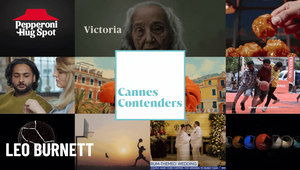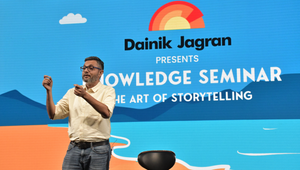
How Leo Burnett is Taking New Age India to the Global Stage

Five years ago or so, Dheeraj Sinha and Rajdeepak Das started on a journey to build an agency fit for the new age of India, alive with tech innovation and entrepreneurialism. Their aim was to create the number one agency in India. This year at Spikes Asia, the agency was named the number one agency in Asia.
Work like last year’s The Missing Chapter, which took at Grand Prix at Cannes in the Sustainable Development Goals Lions (and which is in the running for the Creative Effectiveness category this year), and the joyfully nostalgic cricket World Cup creative for Oreo that rolls back the clock to 2011, the last time India reigned victorious (and the year Oreo launched in the country), has seen the agency ride high in the region - and Dheeraj reckons the next goal is for the agency to shake things up globally.

But let’s rewind. How did Dheeraj and Rajdeepak shape this agency, and how did the agency get to where it is today?
These days Dheeraj is CEO of Leo Burnett South Asia as well as being chairman of BBH India while Rajdeepak is CCO and CEO, Leo Burnett, SouthAsia, India and chairman of Publicis Groupe’s South Asia creative council. Dheeraj joined Leo Burnett as Chief Strategy Officer for South Asia from Grey in 2016. In 2018 he stepped up as managing director of India and at that point he and Rajdeepak, who had been chief creative officer since 2014, decided they wanted to create something new.
“We were very clear that a lot of the success in India with other agencies had been in the traditional space, doing these amazingly popular television pieces. It's’ great work and I have a lot of respect for all that was done… but we were very clear that if we are building a new agency it cannot be yet another traditional agency.”
In what Dheeraj describes as a “deliberate planting of the flag”, one of the first things he did was come up with the language that would serve as a compass to their journey. After speaking to a handful of startup founders, he cracked it and wrote the phrase “Number 1 New Age Agency” on the credentials deck.
And then the hard work began. They embarked upon a process of restructuring, emptying out the middle to create an ‘hourglass’ shaped agency with leaders and swathes of hierarchy-free, enterprising young people. They started looking for people with “mutant DNA”, people who were not pigeonholed and came along with multiple skills. Instead of the usual talent hunting grounds, they went to India’s top colleges like Indian Institutes of Technology, the National Institute of Design and Ashokha University.
“We weren't hiring for copywriting or art skills, we were hiring for solutioning skills. Can you solve a business problem? Can you solve a human problem? Craft - we can teach.”
And with those new talents came new culture. Dheeraj speaks fondly of what he describes as a “culture of camaraderie”. He and Raj don’t squirrel themselves away behind closed doors. It’s a case of getting out there and mucking in in the agency’s open plan, fluid offices. The word ‘swagger’ pops up quite a bit too - a boisterous, playful confidence.
Dheeraj has taken his inspiration from India’s fizzing tech landscape, companies like boAt, the world’s fifth largest wearables brand (https://www.boat-lifestyle.com/blogs/news/boat-creates-history-becomes-5th-biggest-wearable-brand-in-the-world)or Acko, India’s fastest growing online insurance company, which are also Burnett clients.
“There are a lot of homegrown Indian brands, started by young entrepreneurs, doing well, not just in India but now having a global impact,” says Dheeraj.
Conversely, the international tech giants have sought out the team to help them land and grow in India. Amazon and Spotify have been built in India by Leo Burnett (check) and for the past couple of years they’ve been working on Meta’s B2B business and they’re also helping Airtel, the largest telecom service provider in India, with their 5g launch.
“So, I think what is happening in the Indian landscape is the new startups are bringing a lot of energy, a huge amount of energy. Working with them, you’ve got to know how you can scale something very, very fast. You cannot work like a traditional advertising agency. For example, one of my golden rules in my ten is we never ask for more time from clients. We don’t do that. That’s a classic advertising thing to do and we don’t do that.”
Another change that Dheeraj relishes is the shape and ambition of briefs coming in the door.
“They’re solving large Indian problems as well… our briefs are never ‘we’ve got to reposition the brand’. Never ‘we need another campaign’. They’re, ‘we’ve got 20 million people, can we get 40 million more’. They’re all business outcome-led briefs, and it’s for us to solve them. It could be a gambit (check), it could be an innovation, it could be a feature, it could be an ad. That changes your thinking because you’re honking upstream with the founders, you’re solving the problem, not responding to a marketing brief.”
Dheeraj has also been learning from India’s founders via his popular podcast Speakeasy with Dheeraj Sinha. And that has had quite a profound impact on his own perspective as a leader.
“The one thing I learned was that a lot of those founders, most of the successful ones, are not just in it for the business, they are in it to leave a legacy” he says, revealing that they’re often deeply aware of their mortality. “So behind this whole hustle and mad rush to raise money and so forth, behind every founder I’ve seen a very large vision to solve a problem, to leave something very tangible behind.”
One unintended consequence of the agency’s focus on India’s new age businesses is that the reputation they’ve been building has made them popular with clients from more traditional sectors and businesses. As they’re seeking to transform and connect with modern Indians, they’re looking for partners already playing in that pool.
Of course, you don’t get much more ‘new age’ right now than the AI explosion. “I love it,” enthuses Dheeraj. “I am excited about this change. I have absolutely zero insecurities that this will eat up our jobs.”
It’s a space that Leo Burnett has already been getting stuck into. He points to a recent update of a project first launched four years ago called Roads That Honk . This project used sensors that alerted drivers approaching hairpin bends to any oncoming vehicles. Now, using a cloud-based machine learning programme, they’re able to map the traffic, generating data and insight. They’re working with the Ministry of Road Transport, who can then use this insight for traffic management.
Indeed, Dheeraj believes the AI boom has the potential to turbocharge the kind of creative solutions the team can devise for clients. It also frees up talent to focus on creativity rather than the mundanities of grinding out hundreds of social posts by hand.
“Then I feel like our industry goes back to legitimately doing what it was always designed to do, which is use creativity to solve business problems and make 1 + 1 = 11.”
Another significant factor behind Leo Burnett’s success across South Asia is the ability to draw from Publicis Groupe’s beefed up capabilities, for example in commerce, data and in production with Prodigious. That allows the team even greater flexibility in the kinds of creative solutions it can devise. “It’s a give and take relationship - we are a very high energy, creative hotshop within the system,” says Dheeraj. “It’s a very healthy, positive and happy kind of symbiotic relationship.”
Leo Burnett India has been on a transformational journey - but of course the problem with creating the agency of the future is that, as the future becomes the present, a new future appears. The work never stops. But the team’s ambition keeps growing too.
“My whole thing with our business is that if you are inventing the future, you could be number one in the world. That’s where our ambition is; we want to make a global impact, we want to create work which will define the future of our business.”












